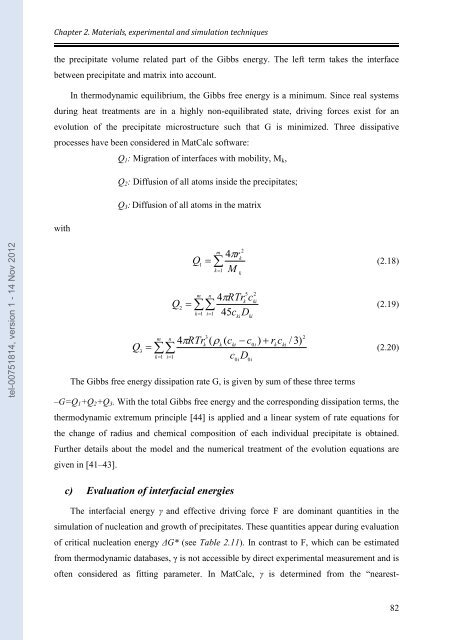Etude par Sonde Atomique Tomographique de la formation de nano ...
Etude par Sonde Atomique Tomographique de la formation de nano ...
Etude par Sonde Atomique Tomographique de la formation de nano ...
You also want an ePaper? Increase the reach of your titles
YUMPU automatically turns print PDFs into web optimized ePapers that Google loves.
tel-00751814, version 1 - 14 Nov 2012<br />
Chapter 2. Materials, experimental and simu<strong>la</strong>tion techniques<br />
the precipitate volume re<strong>la</strong>ted <strong>par</strong>t of the Gibbs energy. The left term takes the interface<br />
between precipitate and matrix into account.<br />
In thermodynamic equilibrium, the Gibbs free energy is a minimum. Since real systems<br />
during heat treatments are in a highly non-equilibrated state, driving forces exist for an<br />
evolution of the precipitate microstructure such that G is minimized. Three dissipative<br />
processes have been consi<strong>de</strong>red in MatCalc software:<br />
with<br />
Q1: Migration of interfaces with mobility, Mk,<br />
Q2: Diffusion of all atoms insi<strong>de</strong> the precipitates;<br />
Q3: Diffusion of all atoms in the matrix<br />
Q<br />
3<br />
� m<br />
n<br />
��<br />
k�1<br />
i�1<br />
Q<br />
2<br />
Q<br />
1<br />
� m<br />
�<br />
k�1<br />
� m<br />
n<br />
��<br />
k�1<br />
i�1<br />
2<br />
4� rk<br />
(2.18)<br />
M<br />
k<br />
5<br />
4�RTrk<br />
c<br />
45c<br />
D<br />
ki<br />
0i<br />
ki<br />
0i<br />
2<br />
ki<br />
3<br />
4�RTrk ( �k<br />
( cki<br />
� c0i<br />
) � rkc<br />
c D<br />
ki<br />
/ 3)<br />
The Gibbs free energy dissipation rate G, is given by sum of these three terms<br />
2<br />
(2.19)<br />
(2.20)<br />
–G=Q1+Q2+Q3. With the total Gibbs free energy and the corresponding dissipation terms, the<br />
thermodynamic extremum principle [44] is applied and a linear system of rate equations for<br />
the change of radius and chemical composition of each individual precipitate is obtained.<br />
Further <strong>de</strong>tails about the mo<strong>de</strong>l and the numerical treatment of the evolution equations are<br />
given in [41–43].<br />
c) Evaluation of interfacial energies<br />
The interfacial energy γ and effective driving force F are dominant quantities in the<br />
simu<strong>la</strong>tion of nucleation and growth of precipitates. These quantities appear during evaluation<br />
of critical nucleation energy ΔG* (see Table 2.11). In contrast to F, which can be estimated<br />
from thermodynamic databases, γ is not accessible by direct experimental measurement and is<br />
often consi<strong>de</strong>red as fitting <strong>par</strong>ameter. In MatCalc, γ is <strong>de</strong>termined from the “nearest-<br />
82

















